外研版英语七年级上册语法总结
2024七年级英语上册外研版重点短语句型汇总

2024七年级英语上册外研版重点短语句型汇总Starter Welcome to junior high!初级中学放入为......做好准备如何将要做某事教学楼在操场上踢足球在一/二/三楼放学后喜欢做某事帮助某人某事想要做某事在海里一点点交朋友Unit 1 A new start对......感到兴奋谈论像和......交谈写下/记下跳进思考/思索从......中学习在......的结尾把......给......发现指出/指明仰望/抬头看举高/张贴事实上犯错误要求某人做某事上一堂精彩的课看介绍自己下次例如许多各种各样的使用/利用一天天准时/按时独自努力学习与某人分享某物经历/经受代表向某人展示某物尽某人最大努力远航保护......免受......的伤害未来与......相似在......的帮助下做某事(对某人来说)是......的Unit 2 More than fun摇滚乐弹吉他在那一刻拉二胡决定做某事在舞台上出自一种冲进参加/加入点燃很长一段时间许多/大量直到......蔡从那时起成百上千的对......有兴趣一等奖了解开始做某事少许社交媒体以......为例举起/抬起需要做某事尽力做某事飞走起飞在午夜摇某人的头稍微/有点儿想要做某事环绕一圈在最后一页走过去停止做某事喜欢做某事结交朋友玩的开心与某人握手停止做某事(正在做)停止做某事(去做)Unit 3 Family ties在......之间在这一过程(经历)中第一次在某人的背上对......感到高兴接管开始做某事使想起留下在某人心中在......前面拍照在屏幕上在......的帮助下在远方求助下解决问题为了提供某物打扮成......接某人和某人亲近待在家里外出感觉像......首先/起初比......更重要不得不做某事每天有一天拒绝做某事想起主动提出做某事花费时间陪某人在某物上花费时间/金钱花费时间/金钱做某事Unit 4 Time to celebrate来在春节一块为某人做饭在电话里在餐厅家人团聚违法震惊于......熬夜用英语最好的部分充满了......在南方发生/举行在北方数百万的在墙上在家砍到在客厅放弃充分利用坚守/支持......之一......在......的心中充满着......看见某人做某事浪费时间/金钱打算做某事意味着做某事休息一下面对挑战对某人/某事有耐心支持某人做某事Unit 5 Fantastic friends在公园里到处最好是.......对......误解在镜子里以......的速度像......一样快看起来像在河里在树上在河边捕鱼例如与......一起共事在......几岁时第一次见面变得更好安祥地受伤彻底死亡过去是真实的另外/更重要的是在世界各地灭绝成千上万的大量结果充满Unit 6 The power of plants上升到很多休息一下在地球上变成送上来对......有用变暗大量/许多超过/不只是长成变成在雨林中进入给某人某物......的不同部分走过/穿过在......的顶部在森林里以不同的方式被用于做某事部分对......有益像......一样多出国留学超过/不只是整天回来不仅......而且......一杯在庭院里发送某物给某人......的重要性把......与......进行对比更喜欢做某事喜欢做某事胜过某事为某人选择某物做某事的秘诀与某人聊天与......相连接使某人做某事。
外研版初一上册英语语法总结【三篇】

导语:英语语法虽然是从简单的⼀些⽇常⽤语出发的,但语法中常会有⼀些知识点看起来很细⼩,容易被忽视,但这些知识点掌握不熟练,往往会造成⼀些语法应⽤上的错误。
以下是⽆忧考整理的外研版初⼀上册英语语法总结【三篇】,希望对⼤家有帮助。
1.陈述句肯定陈述句a)Thisisabook.(be动词)b)Helooksveryyoung.(连系动词)c)Iwantasweatlikethis.(实义动词)d)Icanbringsomethingstoschool.(情态动词)e)There’sacomputeronmydesk.(Therebe结构)否定陈述句a)Thesearen’ttheirbooks.b)Theydon’tlooknice.c)Katedoesn’tgotoNo.4MiddleSchool.d)Katecan’tfindherdoll.e)Thereisn’tacathere.(=There’snocathere.)2.祈使句肯定祈使句a)Pleasegoandasktheman.b)Let’slearnEnglish!c)Comein,please.否定祈使句a)Don’tbelate.b)Don’thurry.3.疑问句1)⼀般疑问句a)IsJimastudent?b)CanIhelpyou?c)Doesshelikesalad?d)DotheywatchTV?e)Isshereading?肯定回答:a)Yes,heis.b)Yes,youcan.c)Yes,shedoes.d)Yes,theydo.e)Yes,sheis.否定回答:a)No,heisn’t.b)No,youcan’t.c)No,shedoesn’t.d)No,theydon’t.e)No,sheisn’t.2)选择疑问句Isthetablebigorsmall?回答It’sbig./It’ssmall.3)特殊疑问句①问年龄HowoldisLucy?Sheistwelve.②问种类Whatkindofmoviesdoyoulike?Ilikeactionmoviesandcomedies.③问⾝体状况Howisyouruncle?Heiswell/fine.④问⽅式Howdo/canyouspellit?L-doubleO-K.Howdowecontactyou?***********************************.⑤问原因Whydoyouwanttojointheclub?⑥问时间What’sthetime?(=Whattimeisit?)It’saquartertotena.m..Whattimedoyouusuallygetup,Rick?Atfiveo’clock.Whendoyouwanttogo?Let’sgoat7:00.⑦问地⽅Where’smybackpack?It’sunderthetable.⑧问颜⾊Whatcolorarethey?Theyarelightblue.What’syourfavouritecolor?It’sblack.⑨问⼈物Who’sthat?It’smysister.Whoistheboyinblue?Mybrother.Whoisn’tatschool?PeterandEmma.WhoareLisaandTimtalkingto?⑩问东西What’sthis/that(inEnglish)?It’sapencilcase. Whatelsecanyouseeinthepicture?Icanseesomebroccoli,strawberriesandhamburgers. 11问姓名What’syouraunt’sname?HernameisHelen./She’sHelen.What’syourfirstname?Myfirstname’sBen.What’syourfamilyname?Myfamilyname’sSmith.12问哪⼀个Whichdoyoulike?Ilikeoneinthebox.13问字母Whatletterisit?It’sbigD/smallf.14问价格Howmucharethesepants?They’re15dollars.15问电话号码What’syourphonenumber?It’s576-8349.16问谓语(动作)What’shedoing?He’swatchingTV.17问职业(⾝份)Whatdoyoudo?I’mateacher.What’syourfather?He’sadoctor.。
初中英语新外研版七年级上册Starter语法详细解析(名词+冠词)

七年级英语上册Starter语法解析一、名词解析*定义: 名词的数指数量,即“多少”。
单数:表示“一”;复数:表示“多于一”*名词可数性: 可数名词和不可数名词*可数名词单数变复数规则1.一般情况直接加s 如:star -- stars; book -- books 等2.以字母s, x, sh, ch等结尾词直接加es 如:bus --buses; watch -- watches等3.以字母f或fe结尾的词将f或fe变为v再加 es 如: leaf--leaves; knife -- knives等4.以辅音字母加y结尾的词变y为i再加es如: baby -- babies; city -- cities等5.以元音字母加y结尾的词直接加s 如:toy-- toys; monkey -- monkeys等6.以es, se, ze, ge等结尾的词直接加s 如:face -- faces; orange--oranges等7.以辅音字母加o结尾的词若表示有生命力则加es如:tomato--tomatoes; hero --heroes等若表示无生命力则加s 如:photo --photos 等8.不规则变化改a为e型: man--men; woman -- women改oo为ee型: tooth--teeth; foot --feet在词尾加-ren: child -- children单复数形式相同: sheep; deer; Chinese; Japanese常用复数形式或只有复数形式: noodles; glasses; trousers; thanks; clothes; chopsticks; people等其他特殊形式: mouse --mice老鼠; mouse -- mouses 鼠标注意: 1.有些以f或ef结尾的词直接加s变成复数:如:roof--roofs; chief--chiefs等2.由man和woman 构成的合成词,其复数形式需前后都变复数:如:man doctor -- men doctors; woman teacher -- women teachers等3.名词作定语修饰另一个名词时,通常只变后一个名词:如: boy student ---boy students; apple tree -- apple trees等*不可数名词的量化:通常不可数名词没有复数形式,不能用a/an修饰,且不能用数词直接修饰。
外研版七年级英语上册语法知识点汇总
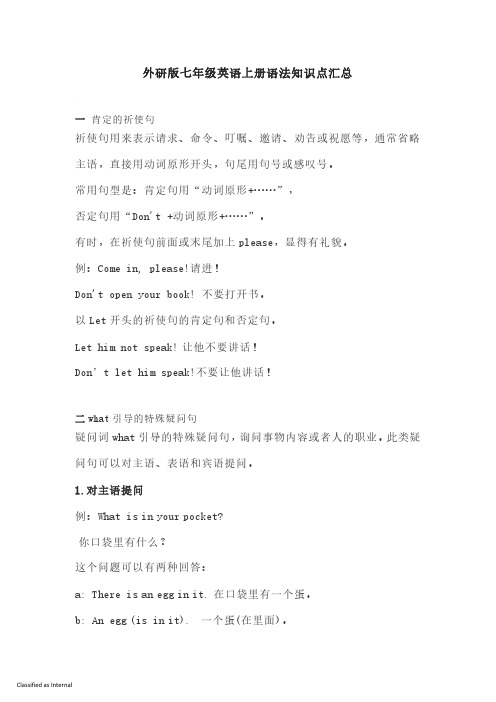
外研版七年级英语上册语法知识点汇总一肯定的祈使句祈使句用来表示请求、命令、叮嘱、邀请、劝告或祝愿等,通常省略主语,直接用动词原形开头,句尾用句号或感叹号。
常用句型是:肯定句用“动词原形+……”,否定句用“Don't +动词原形+……”。
有时,在祈使句前面或末尾加上please,显得有礼貌。
例:Come in, please!请进!Don't open your book! 不要打开书。
以Let开头的祈使句的肯定句和否定句。
Let him not speak!让他不要讲话!Don’t let him speak!不要让他讲话!二w hat引导的特殊疑问句疑问词what引导的特殊疑问句,询问事物内容或者人的职业。
此类疑问句可以对主语、表语和宾语提问。
1.对主语提问例:What is in your pocket?你口袋里有什么?这个问题可以有两种回答:a: There is an egg in it.在口袋里有一个蛋。
b: An egg(is in it). 一个蛋(在里面)。
-What are there in the room?屋子里有什么?-There are a lot of chairs in it. 里面有许多椅子。
注意:回答此句型的问题时,答句的单复数根据实际情况而定。
2.对宾语提问例:-What did you buy?-你买了什么?-I bought a bike.-我买了辆自行车。
3.对表语提问例:-What is this?-这是什么?-It's a bench. -这是一条长凳。
-What is your mother? -你妈妈是干什么的?-She is a teacher. 她是一名老师。
注意:What is+人? 此句型询问人的职业。
还可用What is sb's job?或者What does/do sb. do? 询问人的职业。
三情态动词can表请求情态动词can表请求can除了表示“能够(强调能力)”的含义,还可以表示“能否”的含义。
外研版七年级上册英语全册知识点归纳
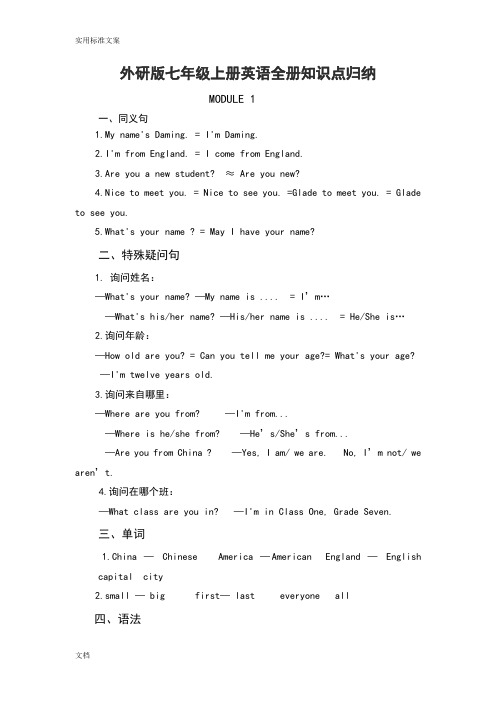
外研版七年级上册英语全册知识点归纳MODULE 1一、同义句1.My name's Daming. = I'm Daming.2.I'm from England. = I come from England.3.Are you a new student? ≈ Are you new?4.Nice to meet you. = Nice to see you. =Glade to meet you. = Glade to see you.5.What's your name ? = May I have your name?二、特殊疑问句1. 询问姓名:—What's your name? —My name is .... = I’m…—What's his/her name? —His/her name is .... = He/She is…2.询问年龄:—How old are you? = Can you tell me your age?= What's your age?—I'm twelve years old.3.询问来自哪里:—Where are you from? —I'm from...—Where is he/she from? —He’s/She’s from...—Are you from China ? —Yes, I am/ we are. No, I’m not/ we aren’t.4.询问在哪个班:—What class are you in? —I'm in Class One, Grade Seven.三、单词1.China —Chinese America —American England —Englishcapital city2.small — big first— last everyone all四、语法1.代词人称代词主格 I you he she it we you they形容词性物主代词(…的) my your his her its our your their2.be动词:am I am= I’m I am not= I’m notis He /She is = He’s /She’s is not = isn’tare We /You /They are = We’re / You’re /They’re are not= aren’tMODULE 2一、单词grandparents grandfather—grandmother parents father—mother mum---dad daughter—son sister—brother aunt—uncle cousin husband---wife family woman---man women---men职业:job actor driver doctor manager nurse worker teacher policeman工作地点:factory hospital hotel office school theatre bus station shop二、短语a photo/picture of my family in front of in/at the frontof next toon the right --- on the left三、语法1.this---that these---those I---we he/she/it---they2.名词所有格:Miss Li's =her Tom’s = hisLily and Lucy's 两人共有的 eg: Lily and Lucy's desk is big Lily's and Lucy's 两人各有的Lily's and Lucy's desks are small.My parents’ room is very clean.四、句子1.---Is this your sister? --- Yes, it is. No, it isn’t---Are these her books? ---Yes, they are. No, they aren’t.2.---Who is this? --- This is my brother.--- Who are they/these? --- They are my cousins3. ---What’s your sister’s name?---My sister’s name is…/Her name is…4.---What does your father do?=What is your father's job?=What is your father?---He is a ...MODULE 3一、单词1.buildings: classroom, dining/sports hall, library, office, science lab, playground2.something: blackboard, book , room, computer, desk, furniture, map,wall,picture, television3.numbers: thirteen fourteen fifteen sixteen seventeen eighteen nineteenthirty forty fifty sixty seventy eighty ninety4.介词:next to ≈ near behind ≠ in front of in/at the front of:在......里面的前面in on under5. in the middle of on the left of--- on the right ofbetween …and… a map of our school6.right 正确的≠wrong右边的≠left二、句子1. Where is the office building ? It is between the dining hall and the library.2. How many students are there in your class? There are 38 students in my class.三、语法(There be)----Are there any school offices?----Yes, there are. There are some offices.----Is there a computer on Miss Li's desk?----No, there isn't.注意:1.就近原则:1). There is an orange and two apples on the desk.There are two apples and an orange on the desk.2). There are some students in the classroom.Are there any students in the classroom? Yes, there are. No, therearen’t3)There aren’t any students in the classroom.There isn’t an orange on the desk.MODULE 4一、family members:aunt uncle grandma grandmother grandpa grandfather mother father mum dad sister brother二、短语句型Thank you for your email.your help.helping me.asking me.inviting me.Make a family tree for your family.----How many people are there in your family?----There are four. There are my mum and dad, my sister and me.----Have you got an aunt?/any .....?----Yes,I have./No,I haven't.----Have you got a small family or a big family?----I've got a big family.or的用法:①或; (选择疑问句)②并列否定:I don't like swimming or dancing.MODULE 5-6一、单词1. orange 橙汁 have some orange [U]橙色 the oranges are orange [C]橙子 This is an orange [C]2.kind 善良 He is very kind.种类=tyre a kind / type of fruit two kinds /types of fruits3. gym: 不受天气影响的室内体育馆、健身房或运动馆stadium: 周围有看台的露天大型运动场4.healthy ≠ unhealthy keep/stay healthy保持健康in good health ≠ in poor/bad healthbe healthy = be in healthbe good for one’s health ≠be bad for one’s health名词变复数条件变化形式例词一般情况 + - s shops单词以s、x、ch、sh结尾 + - es buses以辅音字母+y结尾去y为i + -es city-cities单词以“o”结尾有生命+ - es tomatoes无生命 + - s zoos 一些以‘f’或‘fe’结尾的单词把’f‘或’fe‘变成’ves' knife-knives二、短语三、句型四、区别MODULE 7一、短语talk about sth.谈论某事talk to sb. 跟某人谈话(一方讲一方听)talk with sb. 跟某人谈话(双方都讲)get up≠go to bedgo home≠leave home(for)study science/history/chemistry/maths/...二、语法①时间表达法:What's the time? =What time it is?顺读法: It's two ten. 2:10 (直接读出数字)逆读法:①It's ten past two.(2:10) ≤30'②It's ten to ten. (2:50) >30'整点表达法:It's two o'clock. (2:00) 注意: (不用介词)②一般现在时(1)【No. 1】一般现在时的功能1.表示事物或人物的特征、状态。
外研版七年级上册英语语法及知识点

【导语:】本篇⽂章是⽆忧考为您整理的外研版七年级上册英语语法及知识点,欢迎⼤家阅读鉴赏。
1、名词 A)、名词的数 我们知道名词可以分为可数名词和不可数名词,⽽不可数名词它没有复数形式,但可数名词却有单数和复数之分,复数的构成如下: ⼀)在后⾯加s。
如:fathers,books,Americans,Germans,apples,bananas ⼆)x,sh,ch,s,tch后加es。
如:boxes,glasses,dresses,watches,wishes,faxes 三)1)以辅⾳字母加y结尾的变y为i再加es如:baby-babies,family-families,duty-duties,comedy-comedies,documentary-documentaries,story-stories 2)以元⾳字母加y结尾的直接加s。
如:day-days,boy-boys,toy-toys,key-keys,ways 四)以o结尾加s(外来词)。
如:radios,photos,但如是辅⾳加o的加es:如:tomatoes西红柿,potatoes马铃薯 五)以f或fe结尾的变f为v再加es(s)。
如:knife-knives,wife-wives,half-halves,shelf-shelves,leaf-leaves,yourself-yourselves 六)单复数相同(不变的)有:fish,sheep,deer⿅⼦,Chinese,Japanese 七)⼀般只有复数,没有单数的有:people,pants,shorts,shoes,glasses,gloves,clothes,socks ⼋)单词形式不变,既可以是单数也可以是复数的有:police警察局,警察,class班,同学,family家,家庭成员 九)合成的复数⼀般只加主要名词,多数为后⼀个单词。
如:actionmovie-actionmovies,penpal-penpals;但如果是由man 或woman所组成的合成词的复数则同时为复数。
外研版英语七年级上册语法总结
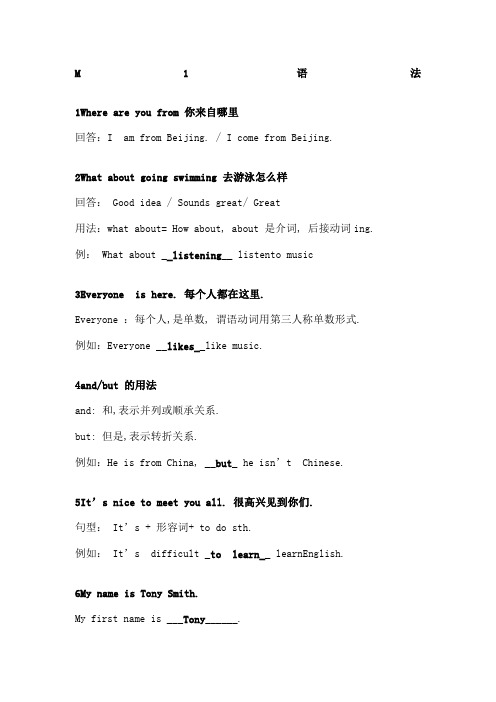
M1语法1Where are you from 你来自哪里回答:I am from Beijing. / I come from Beijing.2What about going swimming 去游泳怎么样回答: Good idea / Sounds great/ Great用法:what about= How about, about 是介词, 后接动词ing.例: What about __listening__ listento music3Everyone is here. 每个人都在这里.Everyone :每个人,是单数, 谓语动词用第三人称单数形式.例如:Everyone __likes__like music.4and/but 的用法and: 和,表示并列或顺承关系.but: 但是,表示转折关系.例如:He is from China, __but_ he isn’t Chinese.5It’s nice to meet you all. 很高兴见到你们.句型: It’s + 形容词+ to do sth.例如: It’s difficult _to learn__ learnEnglish.6My name is Tony Smith.My first name is ___Tony______.my last name is___Smith______.7Be 的用法1. Be 包括 is,am, are.2. Be 搭配口诀: I 用am, you 用are, is 用于he, she, it. 单数和不可数名词用is,复数全用are.3. Be 的肯定变否定,be + not4. Be 的缩写:I am = I’m ; you are = you’rehe is = he’s ; she is =she’s ; it is =it’s; what is =what’s 5. Be 的疑问句:Be + 主语+ 其他回答: Yes, 主语+be. / No, 主语+be not.M2语法1What/How 引导的感叹句What + a/an + 形容词+ 名词 + 主语+谓语= How + 形容词 / 副词+ 主语 +谓语What a big family it is =How big the family isWhat fine weather it is = How fine the weather is2in front of 在前面 / in the front of 在前部3名词所有格两人共有:A and B’s + is两人分别有: A’s and B’s +are例如: Mrs Green is __A__ mother.A. Lingling and Lucy’sB. Lingling’s and Lucy’sC. Lingling’s and Lucy4合成词合成词变复数,一般情况,后面的单词变复数.boy student ___boy students____bus driver __bus drivers______2. 含woman 和man的合成词变复数,两个都要变复数. man teacher ___men teachers_______woman doctor __women doctors_____5What’s your father’s job你的爸爸是做什么工作的= What does your father do= what is your father回答: He is a teacher.6Beijing is the capital of China. 北京是中国的首都. China — Chinese England – EnglishJapan – Japanese America – AmericanAfrica – African7This is a photo of my family. 这是我的一张全家照.a photo of …的一张照片8名词所有格有生命的: Lingling’s books无生命的: a door of classroom表示时间和距离的: two hours’ time我爸爸的一个朋友: a friend of my father’s9方位介词on the left 在左边; on the right 在右边in front of 在前面; next to = near 紧靠in the middle of 在中间10She and Daming’s mother are at the same hospital. 她和大明的妈妈在同一家医院工作.11My father is a bus driver, and he works in a bus station.职业的单词:policeman; doctor; nurse; teacher; actor; manager.M3语法1数字one, two, three, four, five, six, seven, eight, nine, ten.eleven, twelve, thirteen, fourteen, fifteen , sixteen,seventeen, eighteen, nineteen, twenty.thirty, forty, fifty, sixty, seventy, eighty, ninety, hundred. 2What’s your classroom in England like 你在英国的教室是什么样子的be like = look like 看起来像3 a lot of = lots of 许多a lot of / lots of 后接可数名词复数时,等于many; 后接不可数名词时, 等于much.4furniture 家具总称; food ; drink; information 信息,这些词都是不可数名词,用is5some / any 一些1. Some : 用于肯定句表示请求和建议,希望对方肯定回答的句子Would you like some milkWhat about some milkCan I have some milk2. any: 用于否定句和疑问句中例如:I haven’t got __any__ some/any apples.Would you like _some___ some/any apples6on the wall / in the wall 在墙上/在墙里例如: a door is _in the wall______________a map is __on the wall__________7with / and 的区别with 和 and 都有“和”的意思with 强调前者. 例如: Jack with his father __goes____go to park. and 强调两者都.例如: Jack and his father ___go_____go to park. 8There be 句型There be 表示“有” there is / there are含义:表示某地存在某人/某物have:强调某人/某物拥有句型:1肯定句: There is / are + 某人/某物2否定句: There isn’t / aren’t + 某人/某物3疑问句: Is / Are + there + 某人/某物Yes, there is . / No, there isn’t. Yes, there are . / No, there aren’t4. 就近原则: is 和are 的选择由最靠近它的名词的单复数决定.例如: There __is____ a pen and two books.There ___are____ two books and a pen.M4语法1food/drink 不可数名词1drink “饮料”,是不可数名词,用is2drink : have a drink3drink: “喝”, drink tea.2too much /too many 太多1too much + 不可数名词2too many + 可数名词复数3much too + 形容词 much too big3kind 种类1a kind of 一种2different kinds of 不同种类的3be kind to sb. 对某人和蔼4health / healthy 健康/健康的1I t is good for your health, please keep healthy. 2stay healthy; keep healthy; healthy food.5a bit of一点She has __a bit of _____ money. = a little6remember 记得remember to do sth. 记得去做某事remember doing sth. 记得做过某事7or 或者; 还是在肯定句中:表示”或者”在否定句和疑问句中,常用or 来代替 and: I haven’t got a pen or a book.在并列句中:表示“否则”: Hurry up, or you will be late.8have got/has got 句型1. 定义:拥有. have got = have ; has got =has2. 句型:肯定句:主语+ have got /has got +其他否定句:主语+ haven’t got /hasn’t got +其他疑问句:Have /Has+ 主语+ got + 其他回答: Yes, 主语+have/has.No, 主语+haven’t / hasn’t.3.There be 和have got 的区别There be某地存在某人/某物;强调存在;have got 某人/某物拥有...;强调拥有9特问词what 什么 where 哪里 when 何时 who谁 which 哪一个 How 方式或状态What time 什么时刻 How old 多大What colour 什么颜色How often 多少次once / twice / three times10is good for 对…有益反义词 is bad for对…有害11名词1. 可数名词--单数变复数规律:1一般情况:加s2 以s, x, ch, sh 结尾:加esbuses , boxes, watches3以“辅音+y”结尾的,变y为i, 加es. family -families, city- cities 4以f/fe 结尾:把它变成ves. leaf-leaves, wife-wives, knife-knives 5 以o结尾,记口诀: photo-photosNegroes and heroes like potatoes and tomatoes.黑人和英雄喜欢马铃薯和西红柿.6man – men; woman- women; child- children7oo-ee: foot-feet; tooth-teeth; goose-geese8 单复数同型:三人: Chinese; English; Japanese三物: fish; deer; sheep9 特殊单词mouse- mice ; ox- oxen; German - Germans2. 不可数名词1分类:液体类: water; tea; milk 等肉类: meat; fish; beef 等其他类: chocolate; bread; money; sugar; paper; work; homework; time; food; drink; furniture; information 等2用法1. 不可数名词,不用a/an,不加s /es 变复数2. 不可数名词,看作单数,和is 搭配3. 和 a little / little / a bit of 搭配4. 和 much 搭配M5 语法1时间表达法to1. 顺读法It' s + 点钟+ 分钟2. 逆读法It's + 分钟+... + 点钟1小于30分钟:It's + 分钟+ past + 点钟2等于30 分钟:It's + half past + 点钟3大于30分钟: It's + 60-分钟+to+ 点钟+14整点: It's + 点钟+ o'clock5等于15分钟:It's + a quarter past + 点钟6等于45分钟: It's + a quarter to + 点钟+1 2问时间What time is it = What' s the time /回答: It' s + 时刻3because 因为用Why 来提问, 用because 来回答有because 无so, 有though 无but4talk to / talk with 与...交谈5start to do sth 开始去做某事= begin to do sth6have 的用法have : 拥有have breakfast/ have lunch/have dinner : 吃早餐/中餐/晚餐have Chinese : 上语文课have a look : 看一看7house / home / family 的用法house : 房子强调建筑物home: 家乡带有感情色彩family : 家庭或家人8look / see/ watch / read 的用法look at : 看强调动作see: 看强调结果watch : 观赏watch TV/ watch gamesread : 阅读 read books9一般现在时1. 定义表示经常或反复发生的动作2. 用法:1 表示经常发生的动作V原或者V三单2 表示现在的状态Be3 表示客观事实或普遍真理.3. V形Be is /am /are ; V原; V三单当主语是第三人称单数4. 句型1.肯定句:主语+ be + 其他主语+ V原 + 其他;主语+ V三单+其他2.否定句:主语+be +not +其他主语+ don’t + V原+ 其他主语 + doesn’t + V原 + 其他3.疑问句: Be + 主语 + 其他Do + 主语 + V原 +其他Does + 主语 + V原 +其他注意:在主+谓+宾结构中,否定句和疑问句要借助助动词do 或does,助动词do/does 后加动词原形5. 标志词always, usually , often, sometimes, seldom很少, never从不,every day, on Mondays6. 练习题He __plays___ play basketball everyday.Daming __doesn’t like___ not like art .My friends __don’t come____ not come._Does___ the cat _eat____ eat fishWe always __watch____ watch TV.M6 语法1such as 例如2other 其他other animals = others 其他动物one … the other 一个…另一个some … the others 一些…另一些3Shall we go and see them 我们可以去看看他们吗Shall we + V原型祈使句4a little /little + 不可数名词a few / few + 可数名词复数5as well as 并且;还as well as = with 强调前者例如:He as well as his father ___has____ have lunch. 6be good at = do well in 擅长at 和in是介词,后接动词ing.例如: He is good at __swimming_____swimHe does well in __swimming____swimM7语法1connect …to …把…连接到…2turn on 打开; turn off 关闭turn up 调大声; turn down 调小声例如: It’s so dark, please _turn on_ the light.3first 第一序数词; one 一基数词He is the _first____ one to come here.4 表示顺序的词first: 首先 next : 接下来 then: 然后 finally : 最后5finally 最后__Finally____ final, you can click the mouse.6print 打印; printer 打印机Please use the __printer___print7mouse 老鼠;鼠标 miceThere are some __mice____mouse.8share … with…与…分享9plan 计划What’s your plan for your summer holidayI plan __to go___go to Beijing.10sometimes 有时例如:_____C_____ my mother goes to work by taxi.A.Some timesB. Some timeC. Sometimes 11特殊疑问句1结构:特问词+ 一般疑问句2特问词:What 什么 where 哪里 ; who 谁 ; whose 谁的 ;which哪个; when何时; how如何,方式或状态;What time什么时刻; what colour什么颜色How soon多快; in an hour; how long多长; how often 多少次;once; twice; three times; alwaysHow many问数量;可数名词how much问数量;不可数名词;问价格3做题方法:根据答语选择特问词,问什么答什么M8语法1Would you like to come to my birthday party 你愿意来参加我的生日聚会吗Would you like + sth.Would you like to do sth.回答: Yes, I’d love to. / Yes, please.No, thanks. / I’d love to, but…例如: Would you like ___to visit__ visit the Great Wall2give sth. to sb. = give sb. sth.buy sth. for sb. = buy sb. sth.3exercise 练习泛指练习时,是不可数名词:do some exercise特指具体的练习时,是可数名词复数: do eye exercises; do morning exercises.4search for information 搜索信息5use ... to do …用…做…6Do you sing it in Chinese or in English选择疑问句,问什么答什么,不能用Yes/No回答.7wear 穿戴wear: 强调穿戴的状态 wear + 衣服,帽子,眼镜,鞋子put on : 强调穿的动作 Please _put on_ your coatdress : 装扮 dress sb. He dresses himself8choose 选择choose to do sth. 选择去做9paper 不可数名词,用is10 information 不可数名词,用is11spend 花费1. spend 时间或者金钱2. 人+ spend + 时间/金钱 + on sth.人 + spend + 时间/金钱 + in doing sth.例如: It’s said that we’ll have to _D___ one hour ________ to Beijing.A. take; flyingB. takes; to flyC. spends; to flyD. spend; flyingM9语法1a few ; few / a little ; little 的用法2lie 躺着;说谎1. 躺着: lie - lying2. 说谎: tell a lie3enjoy 享受1. enjoy doing sth.例如:They are enjoying _listening_____listen to music.2. enjoy yourself = have a good time 玩得开心4It' s time to go back to school now. 到时间回学校了.句型: It's time to do sth.例如: It's time __to have____ have lunch.5moment 时刻at the moment = at this moment= now=right now用于现在进行时6leave 离开leave A : 离开Aleave for A : 前往A7get on 上车; get off 下车; get up 起床8sleep 睡觉go to sleep 入睡; go to bed 上床睡觉9现在进行时: V 变Ving1. 一般情况:加ing2. 以e结尾:去e加ing : take- taking; make-making3. 双写末尾辅音:swim-swimming; shop-shopping; run-running; sit-sitting; put-putting;begin-beginning4.特殊: lie-lying; die-dying; tie-tying10on the same day 在同一天11lying in the sun 躺在阳光下12by + 方式by bus; by email; by bikeM10语法1happen 发生1. What's happening to you 你发生了什么事= What' s up= What's the matter= What's wrong with you2. happen to do sth. 碰巧做某事例如:Mary happens __to see______ see a cat.2get ready for 为...做准备get ready for sth. = get ready to do sth.例如:We are getting ready for __learning___ learn a dragon dance. = We are getting ready _to learn____ learn a dragon dance. 3join 加入join + 人; join in + 活动4put away 收拾; sweep away 扫地1.名词可以放中间或者后面put the paper away = put away the papersweep the paper away = sweep away the paper2.代词只能放中间put it away / put them awaysweep it away / sweep them away5hurry up 快点Hurry up, or you will be late 快点,否则你就迟到了.hurry to do sth. 匆忙去做某事6look 看have a look 看一看; look at 看have a look at7mean 意味着It means + doing sth. 意味着做某事It means __learning___ learn English is very important. 8celebrate ... with... 以...方式庆祝。
(完整)外研版七年级上英语重点语法
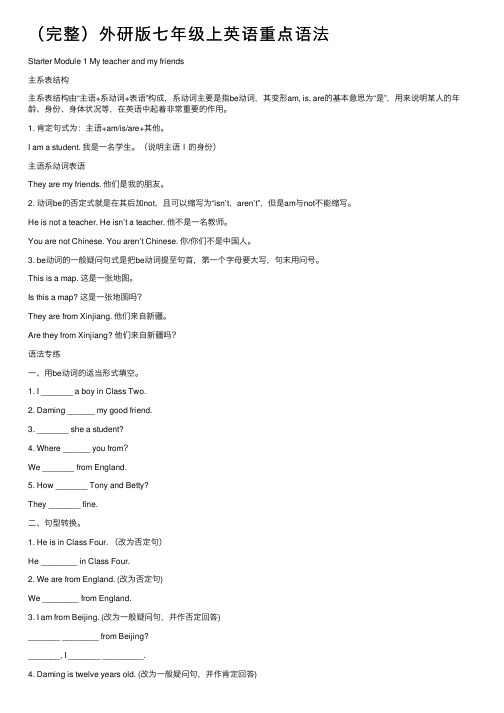
(完整)外研版七年级上英语重点语法Starter Module 1 My teacher and my friends主系表结构主系表结构由“主语+系动词+表语”构成,系动词主要是指be动词,其变形am, is, are的基本意思为“是”,⽤来说明某⼈的年龄、⾝份、⾝体状况等,在英语中起着⾮常重要的作⽤。
1. 肯定句式为:主语+am/is/are+其他。
I am a student. 我是⼀名学⽣。
(说明主语I的⾝份)主语系动词表语They are my friends. 他们是我的朋友。
2. 动词be的否定式就是在其后加not,且可以缩写为“isn’t,aren’t”,但是am与not不能缩写。
He is not a teacher. He isn’t a teacher. 他不是⼀名教师。
You are not Chinese. You aren’t Chinese. 你/你们不是中国⼈。
3. be动词的⼀般疑问句式是把be动词提⾄句⾸,第⼀个字母要⼤写,句末⽤问号。
This is a map. 这是⼀张地图。
Is this a map? 这是⼀张地图吗?They are from Xinjiang. 他们来⾃新疆。
Are they from Xinjiang? 他们来⾃新疆吗?语法专练⼀、⽤be动词的适当形式填空。
1. I _______ a boy in Class Two.2. Daming ______ my good friend.3. _______ she a student?4. Where ______ you from?We _______ from England.5. How _______ Tony and Betty?They _______ fine.⼆、句型转换。
1. He is in Class Four. (改为否定句)He ________ in Class Four.2. We are from England. (改为否定句)We ________ from England.3. I am from Beijing. (改为⼀般疑问句,并作否定回答)_______ ________ from Beijing?_______, I _______ _________.4. Daming is twelve years old. (改为⼀般疑问句,并作肯定回答)_______ Daming twelve years old?_______, he ______.Starter Module 2 My English lesson祈使句1. 祈使句可⽤来表⽰命令、请求和建议等意义的句⼦。
初中英语新外研版七年级上册Unit 4语法讲解(2024秋)

七年级英语上册Unit 4语法讲解一、语法解析(一)频率副词1.频率副词用来表示某一动作发生的频率或某一状态出现的频率,常见的有(按程度由大到小排列)always(总是,一直);usually(通常);often(经常);sometimes(有时);seldom (很少);never(从不)。
2.对频率副词提问常用how often开头3.在句中位置(1)在连系动词be之后。
Eg: She is sometimes very busy.她有时非常忙。
(2)在助动词或情态动词之后。
Eg: I can always remember you.我会一直记得你。
(3)在行为动词之前。
Eg: We often go there. 我们经常去那。
(4)sometimes可放在句首、句中或句末。
Eg: Sometimes she writes to me. 有时她给我写信。
4.用法(1) often, always, usually等常和一般现在时连用,表示现在经常或反复发生的动作。
Eg: I always go to bed at ten o’clock. 我总是10点睡觉。
(2) always可与进行时连用,并不强调动作正在进行,表示赞叹、厌烦等情绪。
Eg: He is always thinking of others.他总是为其他人着想。
She is always asking silly questions.她总是问愚蠢的问题。
(二)一般现在时1.用法:(1)表示经常性或习惯性的动作或现在存在的状态(2)表示人的性格、能力、特征或爱好等。
(3)表示客观真理或普遍事实。
2.句式:(1)肯定句:主语 + 动词原形 + 其它Eg: I often go to school at 7:00. 我经常七点去上学。
(2)否定句:主语 + don’t + 动词原形 + 其它Eg: They don’t sing every morning. 它们每天早上不唱歌。
外研版七年级上册英语知识点归纳总结
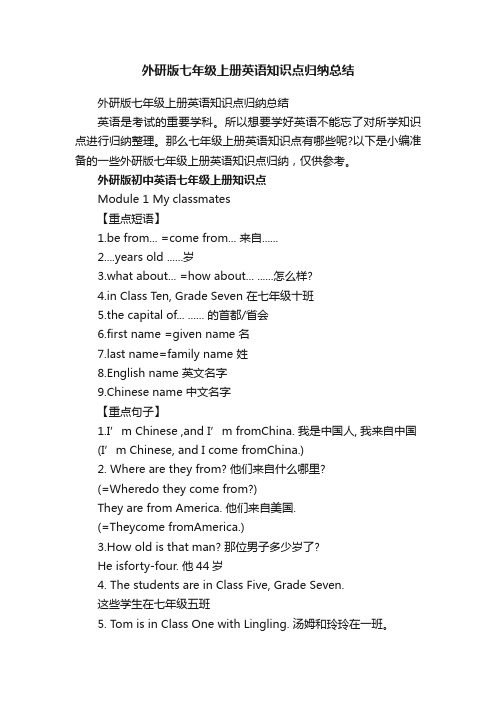
外研版七年级上册英语知识点归纳总结外研版七年级上册英语知识点归纳总结英语是考试的重要学科。
所以想要学好英语不能忘了对所学知识点进行归纳整理。
那么七年级上册英语知识点有哪些呢?以下是小编准备的一些外研版七年级上册英语知识点归纳,仅供参考。
外研版初中英语七年级上册知识点Module 1 My classmates【重点短语】1.be from... =come from... 来自......2....years old ......岁3.what about... =how about... ......怎么样?4.in Class Ten, Grade Seven 在七年级十班5.the capital of... ...... 的首都/省会6.first name =given name 名st name=family name 姓8.English name 英文名字9.Chinese name 中文名字【重点句子】1.I’m Chinese ,and I’m fromChina. 我是中国人, 我来自中国(I’m Chinese, and I come fromChina.)2. Where are they from? 他们来自什么哪里?(=Wheredo they come from?)They are from America. 他们来自美国.(=Theycome fromAmerica.)3.How old is that man? 那位男子多少岁了?He isforty-four. 他44岁4. The students are in Class Five, Grade Seven.这些学生在七年级五班5. Tom is in Class One with Lingling. 汤姆和玲玲在一班。
=Tom with Lingling is in ClassOne.=Tom and Lingling are in Class One.6.What about you?=How about you?=And you?你呢?/你怎么样?7.Welcome to Class 6 Grade 7 ! 欢迎到七年级六班。
外研版七年级英语语法整理

外研版七年级英语语法整理一、介词(Prepositions)介词是一种在句子中表示关系的词语,常见的介词有:at, in, on, to, by, with等。
1.在时间和地点上使用介词:•at:用于“某一时刻”或“某一时间点”,如at 8 o’clock / at night / at the weekend;•in:用于“持续一段时间”,如in the morning / in summer / in 2005;•on:用于“某一天、日期或节日”,如on Monday / on December 25th / on Christmas Day。
2.表示方向的介词:•to:表示“朝向某个地方”,如go to school / walk to the park;•from:表示“从某个地方来”,如come from Beijing;•into:表示“进入某个地方”,如go into the room;•out of:表示“离开某个地方”,如get out of the car。
3.还有其他表示方式的介词:•by:表示“通过某种方式”,如by bus / by bike;•with:表示“伴随着某人或某物”,如with my parents / with a pencil;•for:表示“为了某人或某物”,如buy a gift for my friend。
二、冠词(Articles)冠词是一种词类,分为定冠词(the)和不定冠词(a / an)。
1.不定冠词的使用:•a:用于单数名词以辅音音素(consonant)开头的情况,如a book / a desk;•an:用于单数名词以元音音素(vowel)开头的情况,如an apple / an egg。
2.定冠词的使用:•the:用于特定的人或物,表示“唯一性”,如the sun / the moon / the school。
3.不使用冠词:•一般情况下,不使用冠词表示泛指或抽象意义,如I like music(我喜欢音乐)。
外研版英语七年级上册语法总结
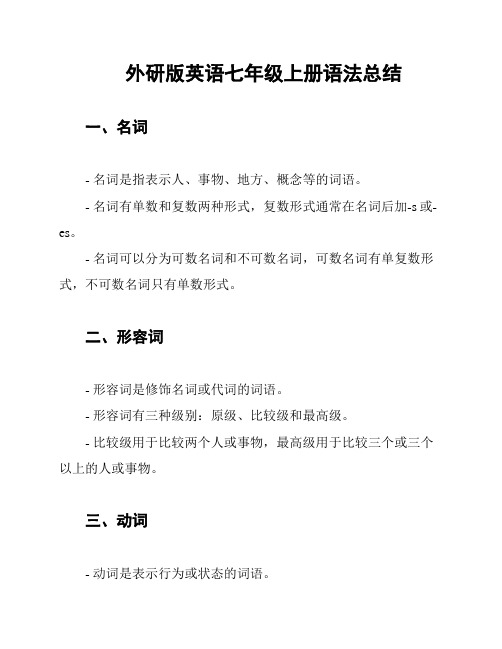
外研版英语七年级上册语法总结一、名词- 名词是指表示人、事物、地方、概念等的词语。
- 名词有单数和复数两种形式,复数形式通常在名词后加-s或-es。
- 名词可以分为可数名词和不可数名词,可数名词有单复数形式,不可数名词只有单数形式。
二、形容词- 形容词是修饰名词或代词的词语。
- 形容词有三种级别:原级、比较级和最高级。
- 比较级用于比较两个人或事物,最高级用于比较三个或三个以上的人或事物。
三、动词- 动词是表示行为或状态的词语。
- 动词有一般现在时、一般过去时和一般将来时等时态。
- 动词的现在分词和过去分词可以作形容词使用。
四、代词- 代词是用来替代名词的词语。
- 代词分为人称代词、物主代词、指示代词和不定代词等。
五、冠词- 冠词是用来限定名词的词语,分为定冠词和不定冠词。
- 定冠词有唯一性,指特指某一个人或物。
六、介词- 介词是连接名词或代词与其他词语之间关系的词语。
- 介词通常放在名词或代词之前。
七、副词- 副词是修饰动词、形容词、副词和句子的词语。
- 副词有程度副词、频率副词和时间副词等。
八、连词- 连词是连接词组、词语或句子的词语。
- 连词可分为并列连词、从属连词和选择连词等。
九、数词- 数词是用来表示数量的词语,分为基数词和序数词。
- 基数词表示具体的数目,序数词表示顺序或次序。
十、感叹句- 感叹句是表达强烈情感或感叹的句子。
- 感叹句常常以感叹词开头,后面跟倒装的句子。
以上为外研版英语七年级上册的基本语法总结,希望对你有帮助。
英语七年级上册重点句型整理(外研版)

七年级上册重点句型整理(外研版)Module1 My classmates【重点句型】1.I’.Chinese.an.I’.fro.China.= I’.fro.China.) 我是中国人.我来自中国.2.---Wher.ar.the.from? =.from? 他们来自什么哪里?---They are from America.=They come from America.) 他们来自美国.3.---Ho.ol.i.tha.man? 那位男子多少岁了?---He is forty-four. 他44岁.4.Th.student.ar.i.Clas.Five.Grad.Seven. 这些学生在七年级五班.5.To.i.i.Clas.On.wit.Lingling.=To.wit.Linglin.i.i.Clas.One.=To.an.Linglin.ar.i.Clas.One.汤姆和玲玲在一班.6.Wha.abou.you?=Ho.abou.you?=An.you? 你呢?/你怎么样?7.Welcom.t.Clas..Grad.7! 欢迎来到七年级六班。
8.Beijin.i.th.capita.o.China. 北京是中国的首都。
9.Goo.t.se.you.=Nic.t.se.you.=Gla.t.se.you. 很高兴见到你。
10.I’.Ton.Smith.Ton.i.m.firs.nam.and . 我是Ton.Smith,Tony是我的名,Smith是我的姓。
Module2 My family【重点句型】1.Thi.i..phot.o.Tony..family. 这是Tony的一张全家福。
2.Wha..bi.family! 多么大的一个家庭啊!3.M.mum’.parent.ar.o.th.right. 我母亲的父母在右边。
4.Th.woma.nex.t.m.i.m.dad’.sister. 紧挨着我的这位女子是我父亲的妹妹。
外研版初中七年级上册
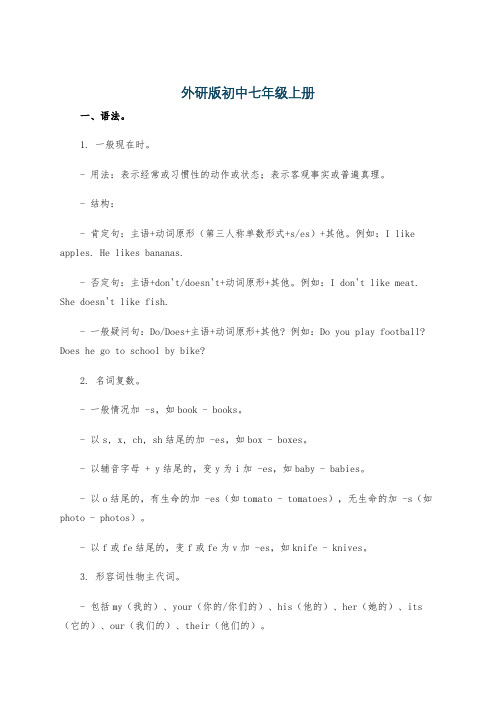
外研版初中七年级上册一、语法。
1. 一般现在时。
- 用法:表示经常或习惯性的动作或状态;表示客观事实或普遍真理。
- 结构:- 肯定句:主语+动词原形(第三人称单数形式+s/es)+其他。
例如:I like apples. He likes bananas.- 否定句:主语+don't/doesn't+动词原形+其他。
例如:I don't like meat. She doesn't like fish.- 一般疑问句:Do/Does+主语+动词原形+其他? 例如:Do you play football? Does he go to school by bike?2. 名词复数。
- 一般情况加 -s,如book - books。
- 以s, x, ch, sh结尾的加 -es,如box - boxes。
- 以辅音字母 + y结尾的,变y为i加 -es,如baby - babies。
- 以o结尾的,有生命的加 -es(如tomato - tomatoes),无生命的加 -s(如photo - photos)。
- 以f或fe结尾的,变f或fe为v加 -es,如knife - knives。
3. 形容词性物主代词。
- 包括my(我的)、your(你的/你们的)、his(他的)、her(她的)、its (它的)、our(我们的)、their(他们的)。
- 用法:后面必须接名词,用来表示所属关系。
例如:This is my book.二、词汇。
1. 家庭成员相关。
- father(父亲)、mother(母亲)、parent(父母)、grandfather(祖父/外祖父)、grandmother(祖母/外祖母)、grandparent(祖父母/外祖父母)、brother (兄弟)、sister(姐妹)、son(儿子)、daughter(女儿)。
2. 学校相关。
- school(学校)、classroom(教室)、teacher(教师)、student(学生)、desk(书桌)、chair(椅子)、book(书)、pencil(铅笔)、pen(钢笔)。
(完整)外研社七年级上册语法总结修正版,文档

七年级上语法总结:第一模块:代词表格人称代词人称主格宾格be 动词的相应形式形容词性物主代名词性物主代词词第一人单数I me am my mine 称复数we us Are our ours第二人单数you you Are your yours 称复数you you Are your yourshe him Is his his第三人单数she her Is her hers称it it Is its its 复数they them are their theirs本卷须知:1.代词主格能够放在句首作主语,名词性物主代词能够放在句首作主语。
2.宾格:放在动词,也许介词此后。
3.形容词性物主代词和形容词相同翻译为。
的,形容词后边加名词,所以形容词性物主代词后加名词。
且形容词性物主代词不能够单独使用,若是使用必定加名词。
4.名词性物主代词=形容词性物主代词+名词第二模块:指示代词指示代词单数复数近指this These远指that those本卷须知1.当出现 over there(在那里〕时,用that 也许 those, 看后边主语,主语复数时用those。
Those are three people over there.That is an apple tree over there.2.用 this 和 that 提问时候,用she/he/it答复。
当能判断出男女的时候,用he/she 答复,当是物是用it 答复。
Is this your pen? Yes it is. No, it isn ’t.Is this your sister? Yes, she is.Is this your brother? Yes, he is.3.当 this/that 作主语时谓语动词用单数。
名词也用单数。
当 these/those 作主语时谓语动词用复数,名词也用复数。
This pen is mine.These pens are mine.第三模块:there be 句型There be 句型表示某地有某人某物。
- 1、下载文档前请自行甄别文档内容的完整性,平台不提供额外的编辑、内容补充、找答案等附加服务。
- 2、"仅部分预览"的文档,不可在线预览部分如存在完整性等问题,可反馈申请退款(可完整预览的文档不适用该条件!)。
- 3、如文档侵犯您的权益,请联系客服反馈,我们会尽快为您处理(人工客服工作时间:9:00-18:30)。
外研版英语七年级上册语法总结集团档案编码:[YTTR-YTPT28-YTNTL98-UYTYNN08]M1语法1】Whereareyoufrom你来自哪里?回答:IamfromBeijing./IcomefromBeijing.2】Whataboutgoingswimming去游泳怎么样?回答:Goodidea!/Soundsgreat!/Great!用法:whatabout=Howabout,about是介词,后接动词ing.例:Whatabout__listening__(listen)tomusic3】Everyoneishere.每个人都在这里。
Everyone:每个人,是单数,谓语动词用第三人称单数形式。
例如:Everyone__likes__(like)music.4】and/but的用法and:和,表示并列或顺承关系。
but:但是,表示转折关系。
例如:HeisfromChina,__but_heisn’tChinese.5】It’snicetomeetyouall.很高兴见到你们。
句型:It’s+形容词+todosth.例如:It’sdifficult_tolearn__(learn)English.6】MynameisTonySmith.Myfirstnameis___Tony______.mylastnameis___Smith______.7】Be的用法1.Be包括is,am,are.2.Be搭配口诀:I用am,you用are,is用于he,she,it.单数和不可数名词用is,复数全用are.3.Be的肯定变否定,be+not4.Be的缩写:Iam=I’m;youare=you’reheis=he’s;sheis=she’s;itis=it’s;whatis=what’s5.Be的疑问句:Be+主语+其他?回答:Yes,主语+be./No,主语+benot.M2语法1】What/How引导的感叹句What+a/an+形容词+名词+(主语+谓语)!=How+形容词/副词+主语+谓语!Whatabigfamily(itis)!=Howbigthefamilyis!Whatfineweather(itis)!=Howfinetheweatheris!2】infrontof在前面/inthefrontof在前部3】名词所有格两人共有:AandB’s+is两人分别有:A’sandB’s+are例如:MrsGreenis__A__mother.A.LinglingandLucy’sB.Lingling’sandLucy’sC.Lingling’sandLucy4】合成词合成词变复数,一般情况,后面的单词变复数。
boystudent___boystudents____busdriver__busdrivers______2.含woman和man的合成词变复数,两个都要变复数。
manteacher___menteachers_______womandoctor__womendoctors_____5】What’syourfather’sjob你的爸爸是做什么工作的?=Whatdoesyourfatherdo=whatisyourfather回答:Heisateacher.6】BeijingisthecapitalofChina.北京是中国的首都。
China—ChineseEngland–EnglishJapan–JapaneseAmerica–AmericanAfrica–African7】Thisisaphotoofmyfamily.这是我的一张全家照。
aphotoof…的一张照片8】名词所有格有生命的:Lingling’sbooks无生命的:adoorofclassroom表示时间和距离的:twohours’time我爸爸的一个朋友:afriendofmyfather’s9】方位介词ontheleft在左边;ontheright在右边infrontof在前面;nextto=near紧靠inthemiddleof在中间10】SheandDaming’smotherareatthesamehospital.她和大明的妈妈在同一家医院工作。
11】Myfatherisabusdriver,andheworksinabusstation.(职业的单词:policeman;doctor;nurse;teacher;actor;manager.)M3语法1】数字one,two,three,four,five,six,seven,eight,nine,ten.eleven,twelve,thirteen,fourteen,fifteen,sixteen,seventeen,eighteen,ninete en,twenty.thirty,forty,fifty,sixty,seventy,eighty,ninety,hundred.2】What’syourclassroominEnglandlike你在英国的教室是什么样子的?belike=looklike看起来像3】alotof=lotsof许多alotof/lotsof后接可数名词复数时,等于many;后接不可数名词时,等于much.4】furniture家具(总称);food;drink;information信息,这些词都是不可数名词,用is5】some/any一些1.Some:用于肯定句(表示请求和建议,希望对方肯定回答的句子)Wouldyoulike some milkWhatabout some milkCanIhave some milk2.any:用于否定句和疑问句中例如:Ihaven’tgot__any__(some/any)apples.Wouldyoulike_some___(some/any)apples6】onthewall/inthewall在墙上/在墙里例如:adooris_inthewall______________amapis__onthewall__________7】with/and的区别with和and都有“和”的意思with强调前者。
例如:Jackwithhisfather__goes____(go)topark.and强调两者都。
例如:Jackandhisfather___go_____(go)topark.8】Therebe句型Therebe表示“有”(thereis/thereare)含义:表示某地存在某人/某物(have:强调某人/某物拥有)句型:(1)肯定句:Thereis/are+某人/某物(2)否定句:Thereisn’t/aren’t+某人/某物(3)疑问句:Is/Are+there+某人/某物?Yes,thereis./No,thereisn’t.Yes,thereare./No,therearen’t4.就近原则:is和are的选择由最靠近它的名词的单复数决定。
例如:There__is____apenandtwobooks.There___are____twobooksandapen.M4语法1】food/drink不可数名词(1)drink“饮料”,是不可数名词,用is(2)drink:haveadrink(3)drink:“喝”,drinktea.2】toomuch/toomany太多(1)toomuch+不可数名词(2)toomany+可数名词复数(3)muchtoo+形容词(muchtoobig)3】kind种类(1)akindof一种(2)differentkindsof不同种类的(3)bekindtosb.对某人和蔼4】health/healthy健康/健康的(1)Itisgoodforyourhealth,pleasekeephealthy.(2)stayhealthy;keephealthy;healthyfood.5】abitof一点Shehas__abitof_____money.=alittle6】remember记得remembertodosth.记得去做某事rememberdoingsth.记得做过某事7】or或者;还是在肯定句中:表示”或者”在否定句和疑问句中,常用or来代替and:Ihaven’tgotapenorabook.在并列句中:表示“否则”:Hurryup,oryouwillbelate.8】havegot/hasgot句型1.定义:拥有。
havegot=have;hasgot=has2.句型:肯定句:主语+havegot/hasgot+其他否定句:主语+haven’tgot/hasn’tgot+其他疑问句:Have/Has+主语+got+其他?回答:Yes,主语+have/has.No,主语+haven’t/hasn’t.3.Therebe和havegot的区别Therebe(某地存在某人/某物;强调存在);havegot(某人/某物拥有...;强调拥有)9】特问词what(什么)where(哪里)when(何时)who(谁)which(哪一个)How(方式或状态)Whattime(什么时刻)Howold(多大)Whatcolour(什么颜色)Howoften(多少次)once/twice/threetimes10】isgoodfor对…有益反义词isbadfor对…有害11】名词1.可数名词--单数变复数规律:(1)一般情况:加s(2)以s,x,ch,sh结尾:加es(buses,boxes,watches)(3)以“辅音+y”结尾的,变y为i,加es.(family-families,city-cities)(4)以f/fe结尾:把它变成ves.(leaf-leaves,wife-wives,knife-knives)(5)以o结尾,记口诀:(photo-photos)Negroes and heroes like potatoes and tomatoes.黑人和英雄喜欢马铃薯和西红柿。
(6)man–men;woman-women;child-children(7)oo-ee:foot-feet;tooth-teeth;goose-geese(8)单复数同型:三人:Chinese;English;Japanese三物:fish;deer;sheep(9)特殊单词mouse-mice;ox-oxen;German-Germans2.不可数名词(1)分类:液体类:water;tea;milk等肉类:meat;fish;beef等其他类:chocolate;bread;money;sugar;paper;work;homework;time;food;drink;furniture;inf ormation等(2)用法1.不可数名词,不用a/an,不加s/es变复数2.不可数名词,看作单数,和is搭配3.和alittle/little/abitof搭配4.和much搭配M5语法1】时间表达法1.It's+2.It's+(1(2)等于to(3)大于点钟+1)(4(5点钟(6+1)2回答:3】用Why有because无so,有though无but4】talkto/talkwith与...交谈5】starttodosth开始去做某事=begintodosth6】have的用法have:拥有havebreakfast/havelunch/havedinner:吃早餐/中餐/晚餐haveChinese:上语文课havealook:看一看7】house/home/family的用法house:房子(强调建筑物)home:家乡(带有感情色彩)family:家庭或家人8】look/see/watch/read的用法lookat:看(强调动作)see:看(强调结果)watch:观赏(watchTV/watchgames)read:阅读(readbooks)9】一般现在时1.定义表示经常或反复发生的动作2.用法:1]表示经常发生的动作(V原或者V三单)2]表示现在的状态(Be)3]表示客观事实或普遍真理。
